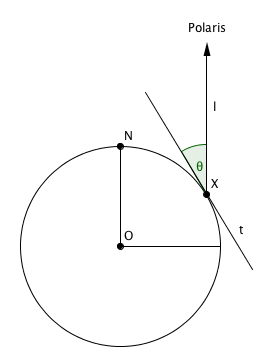
Latitude by the stars

Finding your latitude by the stars. Image courtesy NASA.
How do you find your way around the world? GPS? Well what if you haven't got reception? A map? Good idea, but what if you're travelling on the high seas with no land mark in sight? That's a situation that many, many people have found themselves in over the millennia. These brave seafarers used the Sun and the stars to navigate instead. And to do this, they needed a fair bit of geometry, in particular trigonometry.
Suppose you are on the open ocean and you want to work out your latitude (see here for a definition of latitude). The Sun and most of the stars change their position in the sky over time. But some stars always appear to be in the same place. An example is Polaris, also called the North star, which always appears to be sitting directly overhead the North pole. It turns out that your latitude is the angle at which Polaris appears to sit above the horizon.
To see why, let's look at a two-dimensional picture. Consider the plane that contains the North pole, the point $X$ you are sitting at and the centre $O$ of the Earth. Strictly speaking, Polaris doesn't sit vertically above $X$, as shown in the picture, but it is so far away that the line of sight from $X$ to Polaris is very nearly vertical, so we can pretend that it does.




There is no equivalent of Polaris in the South, but to find your latitude if you are in the Southern hemisphere you can use a constellation called the Southern cross (illustrated on the flag of Australia) and two stars called the Southern Pointers.
Over the millennia navigators have used different devices to measure the angle at which a star appears above the horizon. These include beautiful astrolabes and sextants, which you often find in antique shops and museums.
That sorts out latitude, but how do you work out your longitude? That's another story.
Comments
Anonymous
Et volià — your latitude is given by the angle $\theta $ Polaris sits above the horizontal
"Et voilà " surely
Philip Bradfield (Trinity, 1960)
kindly old pedant
Gus
Ok, but thats half the world. How do you find latitude in Southern Hemisphere?
Tim
Not sure if this was added later - but the answer to this is in the text
There is no equivalent of Polaris in the South, but to find your latitude if you are in the Southern hemisphere you can use a constellation called the Southern cross (illustrated on the flag of Australia) and two stars called the Southern Pointers.